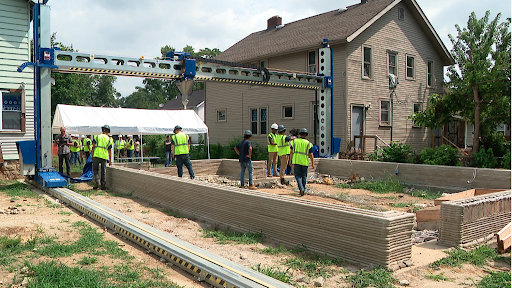When walking past the A&E on your way to and from classes, you may have seen a black cart with a 3D printer. Seeing this type of 3D printer is a likely occurrence in academic settings. Although somewhat expensive, they have become more and more accessible over the past couple of years. Often, they are found in libraries, high schools, and other institutions. These machines function by converting 3D models made on a computer into a set of instructions to form the project layer-by-layer. Once the instructions are finalized, the machine melts a specially shaped 3D filament, laying a thin layer of plastic down and building it up slowly. These types of 3D printers are suitable for smaller, less durable projects. They are typically used for personal use and not intended for industrial settings. However, with further advancements, 3D printing has expanded to using various types of materials, from glass to metal to even concrete!
In the past few decades, there has been a housing crisis in the United States. From 2021 to 2022, the housing shortage grew to 4.5 million homes, up from 4.3 million. Rent is also at an all-time high, and companies are working to find alternative ways to make housing more affordable. One of the solutions developed was to create houses with 3D printers, using more accessible materials, resulting in a lower cost of rent or mortgage. In addition, there are fewer people needed to operate the machine. On average, a house requires a construction team of 26-32 members and approximately 4-8 months to assemble the home. A 3D-printed house takes four workers to set up the machine and around one day to complete the frame.
The strategy for creating a house out of concrete is to use a custom 3D printer to layer concrete to build floors and walls. These machines are designed to be portable, easily constructed, and deconstructed at each construction site. When the printer is running, a nozzle called an

extruder lays a specialized concrete onto the home’s frame. The printer makes several rounds over the frame, stacking layer after layer of materials to form the walls of the home. The printer moves based on guidelines given by a computer program from a digital 3D model of the home, similar to 3D printers that use plastic or other materials.
The plan for a 3D-printed house has been developed in many different ways over previous years, but concrete houses being added to the market is still underway. In August of 2024, the first 3D-constructed home was in progress, being built in Columbus, Ohio.
The field of technology is ever-expanding, and the high demand for housing in the US is an effective way to utilize new developments in construction and improve the economy. What new tasks do you think 3D printing will be used for in the next few years?
By Elisabeth Kheir ‘26, Contributing Writer
26ekheir@montroseschool.org













